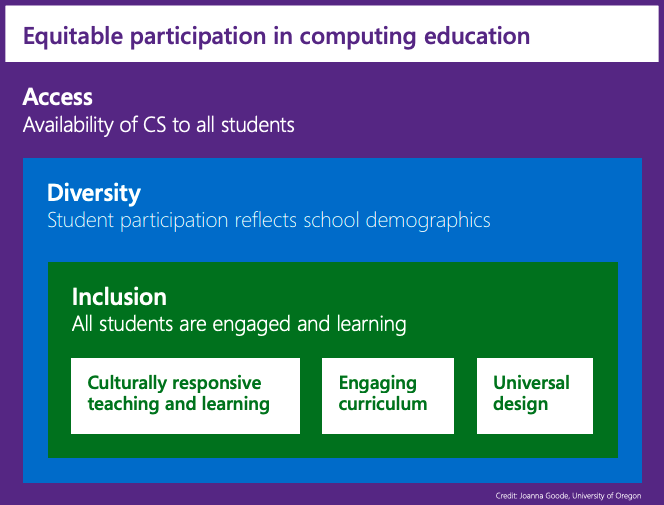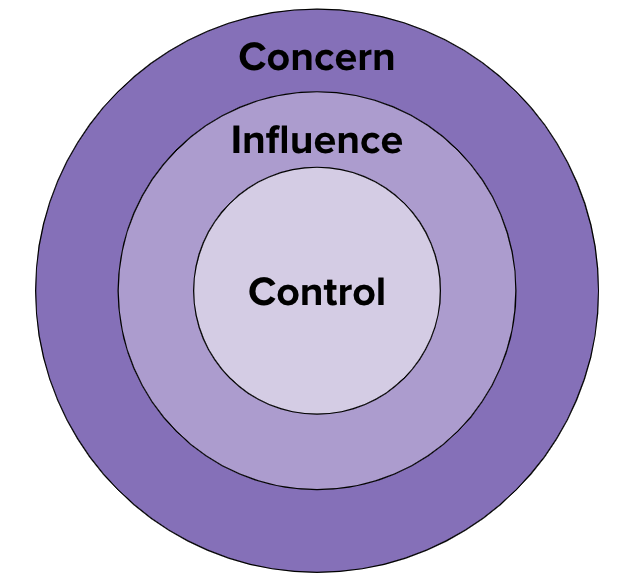Session 2: Recruiting Students to Your CS Principles Classroom
45 minutes
discussion-based
Purpose
This session aims to convince participants that they can and should be champions of CS at their school, and that there are concrete things they can do now to influence who takes their class next year. Teachers are key stakeholders in addressing the equity gap in CS; this session is designed to help participants see themselves as playing a role in the recruitment process.
Objectives
- Participants can identify systemic barriers that limit access, diversity, and inclusion in CS education.
- Participants will list strategies to gather data (quantitative and qualitative) about access, diversity, and inclusion in CS courses locally.
- Participants will analyze access, diversity, and inclusion data from school and classroom to create a recruitment plan.
Supplies & Prep
Room Setup:
- None
Facilitator Supplies:
- CSP Slides - Workshop 2 - 21-22
- Poster for documenting strategies for collecting student data
Participant Materials:
- Computers
- Journals
Agenda
Thinking About Goals and Gaps (10 minutes)
Gathering Data (20 minutes)
Make Your Recruitment Plan (15 minutes)
Facilitation Guide
Thinking About Goals and Gaps (10 minutes)
Facilitator Tip
Some participants may be in a context where they do not need to recruit because every student takes their course. If this is the case, consider having them shift to thinking about retention in their school’s CS program overall, such as enrolling in a future CS course. These participants can also participate in this activity through the lens of, “What can I do to remove barriers that limit access to CS classes in my school?”
(2 minutes) Set Context
💷 Remind participants of the equity cycle, and that the work is ongoing throughout the year to bring access, diversity, and inclusion to their classrooms and schools. Share that during AYW #2, they will be understanding context more deeply to effect change in there own classrooms.
Remarks
In this session, we’ll be talking about the barriers that limit access, diversity and inclusion in CS education, both broadly and within your classrooms. In order to understand the context, we’ll be brainstorming how we can gather and analyze data to create a recruitment plan for your classroom next year. It might seem far away right now, but we know registration happens soon!
Before we get started, let’s talk about how we define access, diversity, and inclusion so that we have a common language to talk about recruiting.
💷 Review definitions of access, diversity and inclusion from the Microsoft Guide to inclusive computer science education.

(6 minutes) 💷 Pair - Share
Prompts:
- What perceptions do students in your building have about your CSP class? What perceptions do you want them to have?
- What prevents some students, specifically the students you’ve identified, from taking the class?
(2 minutes) Share your responses with a partner.
(4 minutes) Whole group share out
Facilitator Tip
You can personalize the statistics slides for your region by visiting code.org/promote/ to access statistics from your state. This includes information such as how many computer science graduates in your state identify as female and the breakdown of AP CSP test takers by ethnicity in your state. This might help drive home the difference participants can make in their local context by changing these numbers to represent the state population overall.
💷 Use the slides to describe the current reality of representation in CS.
Remarks
You can see we have some gaps when it comes to representation in Computer Science. That’s why, when you signed up for this workshop, we asked you to support the recruitment and enrollment of a diverse group of students that represent your school district’s population - you are a crucial piece in the grassroots movement addressing these gaps.
We want to help you develop plans to reach that goal of recruiting students that match your district’s population from an intersectional perspective - meaning we are bearing in mind students’ multiple identities as they relate to your CS classroom. Just as we’ve thought about our own identities before, your students’ identities might include race, socio-economic status, (dis)ability, gender, etc. With this goal in mind, let’s think about the current reality in your building.
Gathering Data (20 minutes)
(8 minutes) Defining the Gap
Remarks
Before we talk specifics about student data, let’s take a moment to reflect on our current CS classrooms.
💷 Think-Pair-Share
(2 minutes) Prompt: Thinking about your school and classroom, who is represented in the school, but is not represented in your class right now?
(2 minutes) Share your responses with a partner.
(4 minutes) Whole group share out.
Facilitator Tip
Sometimes it can be hard to know what building population demographics are without doing some research - this might be especially true for participants who only teach AP courses or who might only teach electives. You might want to recommend participants research their own school demographics through googling it or checking out the National Center for Education Statistics website.
(12 minutes) Gathering Data
Remarks
To better understand the barriers to access, diversity, and inclusion within your own classroom contexts, let’s narrow in on the types of quantitative and qualitative data that might be useful for you to develop and execute on a recruitment plan.
💷 Quantitative data means the quantity (numbers) of something and might guide the type of school data you collect such as:
- Attendance
- School Demographics
- CS course enrollment
- Assessment scores
💷 Qualitative data provides a description of something that may be observed, but not measured and might guide the type of classroom data you collect such as:
- Learner profiles to get to know students and how they think they learn best
- Home/Family life to get to know students outside of your classroom
- Student self-assessment/reflection to get know what contributes or detracts from your students’ learning
💷 Think-Pair-Share
(4 minutes) Prompts:
- What types of quantitative data would you like to see to better understand equity in CS at your school? How might you collect it?
- What types of qualitative data would you like to see to better understand equity in CS at your school? How might you collect it?
(2 minutes) Share your responses with a partner.
Facilitator Tip
If poster paper isn’t available, consider having participants make slides instead.
(4 minutes) Whole group share out. Capture strategies for collecting student qualitative and quantitative data on a poster.
Make Your Recruitment Plan (15 minutes)
Facilitator Tip
The image shows a visual for the Concern-Influence-Control model. In general, what we are concerned about is much larger than what we can influence and/or control. Likewise, what we can control is smaller than the things we can influence.
(5 minutes) 💷 The Concern-Influence-Control Model
Remarks
When thinking about what actions you can take, it can be helpful to think about what your concerns are, what you influence, and what you control.
There might be a lot of things you are concerned about (“Students only have 5 hours in the day, they don’t have enough time in their schedule to take this class”) that you cannot really influence. But there are probably things you can influence (“Special Ed teachers won’t put students in an AP class because they are worried about the homework load”) that you cannot control. And there are things you can control (“My students don’t show their work to their friends outside this class at all”).

(4 minutes) 💷 Write-Share
(2 minutes) In your journal, take notes on which of the barriers you identified earlier this session that you do have control or influence over. Think about which types of quantitative or qualitative data would be useful to understand and remove these barriers.
(2 minutes) Share at your tables.
(10 minutes) Develop the Plan
Remarks
Let’s make our plan! Consider what you can control or influence to get students into your class who represent your building at large from a racial, gender, socio-economic, and dis/ability perspective. What are some things you can do in the next 30 days to reach this goal? What are some things you can do in the next 60 days? What are some things you can do in the next 90 days?
Have participants divide a sheet of paper into 6 sections for their 30-60-90 day plan and what they can control and influence over that time.

(5 minutes) 💷 Write.
(2 minutes) 💷 Share and improve your plan with a partner.
(2 minutes) 💷 Whole group share-out. Ask for 2-3 ideas that people are excited to do in their schools. Encourage participants to reach out to one another during the break to continue to talk about this if interested.
Remarks
Teachers have a lot to do everyday, and it can feel like there is no time to recruit students, but for us to be able to make progress on building an equitable CS program in our buildings, we need to influence and control what we can to make that a reality.
We will be following up on these plans in our next workshop.